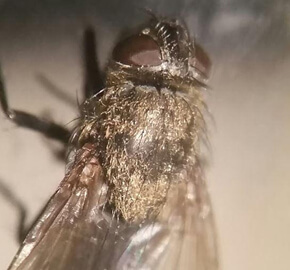Everything You Need To Know About The Cluster Fly
This is a cluster fly. One of the key identification features is the golden hairs on the thorax.
Our technicians found it alive, at the front entrance to our training centre yesterday. Cluster flies can become a serious pest in some areas because they over winter in massive numbers inside houses and other structures. This time of year, tens of thousands may be lying dormant in a single attic or behind the siding, just waiting for the warm weather.
Interestingly, their reproductive cycle includes the earthworm. Female flies lay their eggs at the entrances to earthworm burrows. When the eggs hatch, the larvae migrate into the burrow, and parasitize the worms.
They are not a serious health risk for people as they are not attracted to human food.
Sometimes, however, wall voids and other areas of the home may fill with dead flies. This can lead to secondary pest Infestations. Many species of beetles and ants will take advantage of the fly carcasses as food source.
They are also a nuisance for some homeowners as hundreds may be drawn into the living space of the home in spring and fall, as the flies chase the heat inside, and then end up on the windows following the light.
Interested in more information on flies? Check out our fly section!
